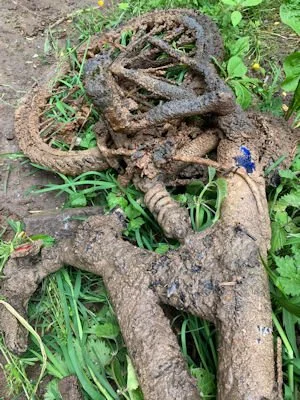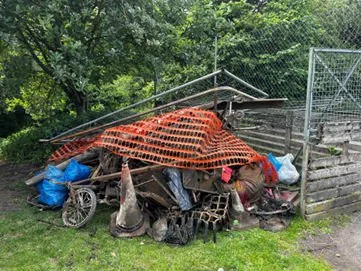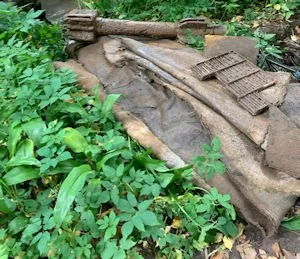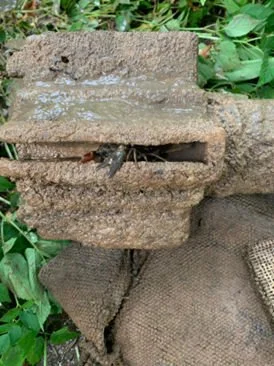St Catherine's Brook cleanup
As part of the recent Wild Waters Festival, Grow Batheaston presented Tales from the Riverbank, an evening of talks and films about rivers, and Batheaston Parish Council organised a River Festival for the village.
With minds so submerged in watery matters, it was no surprise that Grow Batheaston decided it was time to do a stream clean. A working party consisting of Alison Harper and Bill Martin from Grow Batheaston; and Craig Brooks, Nikki Barkwill and Rich Whitehouse from Future Positive (https://futurepositive.agency/) was formed to do the clean and Richard Maccabee, parish clerk for Batheaston Parish Council, helped immensely by arranging the removal of the astonishing pile of rubbish.
Here, Bill Martin describes his day splashing about in the water, and what he plans to do next.
St Catherine’s Brook bubbles up from the earth just Southwest of Marshfield. It runs in a southerly direction and picks up four or five tributaries as it goes down past St Catherine's Court, Oakfield Lane and then through North End to merge with the River Avon near the Fiveways roundabout.
We decided to work from the wooded area beside Rhymes Pavilion up to the primary school, a distance of about 150 metres. This stretch of water is the most visible and the East bank has a right of way.
It’s a pretty area, not heavily used but it looks as though some children play there, maybe mountain biking. It does have a little bit of invasive Himalayan Balsam, which we plan to pull out. But it's a tranquil spot and has a lot of potential as some sort of picnic spot or even a nature trail.
Most of the time there were two of us in the brook working our way upstream, finding and lifting out items of rubbish to pass to the others on the bank who piled them up for disposal. We worked for two and a half hours in the morning and two hours in the afternoon. We had to leave some items, for example a couple of HGV lorry tyres because they were securely embedded in the gravel bed of the brook. But we did manage to remove three lorry tyres; some car tyres; six or seven children's bicycles; up to ten children’s scooters; bits of wood; metal; guttering; rusted up garden chairs and garden furniture; clothing; carpets; a bench from the playing field and more. I was surprised and a bit depressed that such large items of rubbish had found their way into our little stream in the village.
Because of the weight of some items, it took some effort but was hugely worthwhile.
The water wasn’t flowing fast at all. We haven't had rain of any quantity for the last two or three months, so this was Summer time flows. The brook was a couple of feet deep at its deepest and the bed was a little muddy in places but we didn’t feel in any danger.
The water in the brook wasn't what might be described as gin clear. But we did see a fair bit of wildlife. We found some signal crayfish. One of them had been resident in some sort of plastic container and was a little displeased when we extracted it. There were lots of damsel flies dancing round us.
We are hoping to do some further investigations into water quality in St Catherines Brook and the Bybrook. In July there is an Avon wide exercise, called a Water Blitz, which is carried out annually. Bristol Avon Rivers Trust (BART) are the organisers in this area. They supply interested residents with kits which test water for levels of Nitrogen, Phosphorus, Phosphates, Nitrates and also visual clarity and colour. What I hope to do is to sample as far up as possible in the various tributaries of the Bybrook and St Catherine’s Brook. That would establish a baseline of nitrate and phosphate levels as the water comes out of the ground. Then I will sample at various places downstream and ultimately at the outflow into the Avon to see to what extent these Phosphate and Nitrate levels have changed over the course of the water’s flow. The testing process is pretty easy. You're provided with dipsticks and a test tube. You place your water sample into the tube, dip the testing stick into it and then remove it. Over a period of possibly 30 seconds a colour develops on the stick. You compare the colour to a printed colour card to gauge its intensity which is equivalent to X or Y micrograms, or milligrams per litre of Nitrate or Phosphate. It's scientific but it's not at all difficult to carry out. When you have completed the test, you enter the location and the results on a BART form. BART maintains a map of the Avon catchment showing all the results over the years. It's the same sort of sampling that the Environment Agency does. We all have the opportunity to become citizen scientists.
I understand that BART also have a scheme where you can become a River Guardian. If there's a river or a brook running through your community, you could become its guardian. The responsibilities would be to observe the river and its conditions throughout the year; monitor any difficulties that might arise; and possibly sample for various chemicals and maybe even for invertebrates. The latter is called ‘River Fly Monitoring’ which involves kicking a sample of gravel on the floor of the river or stream, collecting the disturbed invertebrates downstream in a net, and then looking for pollution-sensitive bugs such as larvae of mayflies, stoneflies and caddisflies.
I've been fishing on and off for thirty to forty years. While fishing in these small rivers and brooks, you're very intimate with the water. A fly fisherman will get in the water, cast a line and move upstream slowly. So we become aware, we see things, good and bad. Pollution in our rivers damages all the life in them. But river life is resilient. If we stop putting nasty things into the water, it can to a great extent, sort itself out.
We have a wonderful little watercourse on our doorstep which we can look after.
It is a magical ecosystem.






